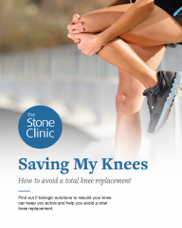Injured Your ACL? Take Care of Your Other Knee Ligaments Too
The knee is tied together by more than just the anterior cruciate ligament (ACL)—though you might not know it when hearing the daily reports of ACL injuries from football, soccer, basketball, and skiing. The “other” knee ligaments matter just as much, and though they’re injured less frequently, their care and feeding determine the function of the knee. The reinforcement of the ligaments on the side of the knee has become a critical step in reducing ACL surgery failure.

Let’s go around the knee.
The medial collateral ligament (MCL) is the ligament on the interior side of the leg. It is often injured when a player is hit from outside the planted leg, causing the knee to bend inward. Fortunately, the MCL, since it is on the outside of the joint with an excellent blood supply, almost always heals without surgery—as long as it is protected during the healing time and mild (but not deforming) stress is applied. This is achieved by moving the knee from 30-90 degrees early after injury and avoiding full extension and side stress. Today, MCL healing—like all superficial ligaments—can be accelerated with the addition of PRP injections early in the healing process.
The posterior cruciate ligament (PCL) crisscrosses the ACL, stopping the tibia from going backwards on the femur. While football can cause this injury, it most often occurs in car accidents when the knee hits the dashboard and is driven backwards, tearing the ligament. It rarely, if ever, heals successfully on its own. Because the repair and reconstruction techniques for the PCL are difficult, many physicians still recommend non-operative care for PCL injuries. If left untreated, however, knees with PCL ruptures often develop meniscus tears and arthritis. And the surgical techniques have improved so much that we usually repair or reconstruct this ligament with donor tissue as soon after the injury as possible.
Take a quick tour of the knee's ligaments
The lateral collateral ligament (LCL) is on the lateral or outside of the knee, extending from the femur to the fibula. Though it is injured much less frequently in sports, an injury can occur if somebody were to cartwheel down a ski slope or get taken out with a side hit in football or soccer. If the injury is isolated to the LCL it can heal on its own; but when found in combination with ACL or PCL issues, the injury often needs to be repaired. The repair is usually done with sutures.
The posterolateral corner of the knee (PLC) is not truly a ligament. It is actually a merger of soft tissues at the back (posterior), and outside (lateral) corner of the knee. The area is significantly injured in up to 30% of ACL injuries—yet the injury is often missed, even when an MRI has been obtained. It is best diagnosed by a careful knee exam that demonstrates a dialing (i.e., rotating) of the tibia off the femur when the leg is bent. Missing the diagnosis, and failing to repair this PLC when the ACL is reconstructed, is a common cause of recurrent knee instability and ACL failure. We rebuild this corner with a donor ligament, which protects the central ligaments and almost always makes the knee feel more stable.
The anterolateral ligament (ALL) is a thickening of the synovium (a layer of tissue that lines the joints and tendon sheaths) at the front outside of the knee. It may be injured when the ACL is torn and can be diagnosed with an MRI. Reinforcing this area with a graft can provide additional stability to the ACL reconstruction.
With ACL injuries—and almost always with ACL revision reconstructions—we now add a reinforcement graft to either the ALL or to the iliotibial band that lives on the side of the knee. This is called a lateral extraarticular reconstruction. These reinforcement procedures have been shown to dramatically reduce ACL reinjury or ACL surgery failure.
So now you know: Many structures are guiding the knee, all of which must be evaluated in any complex knee injury. When you hear about an athlete who injured their ACL, you might ask, "what else was injured?" A careful assessment of the original injury will determine how soon and how well they return to sports. Understanding the complexity of knee ligament injuries guides our care of the knee and the future of the athlete’s sports career.


